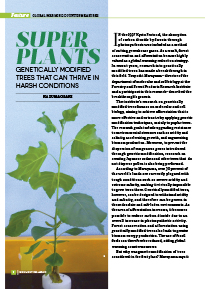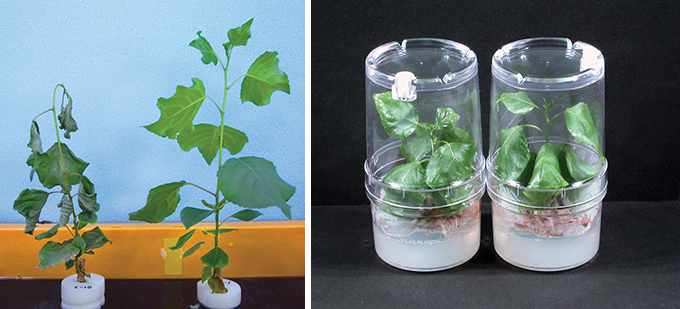Home > Highlighting JAPAN >Highlighting Japan February 2015>Global warming countermeasures
Highlighting JAPAN

Global warming countermeasures
Super Plants
Genetically Modified Trees
that can Thrive in Harsh Conditions

IN the 1997 Kyoto Protocol, the absorption of carbon dioxide by forests through photosynthesis was included as a method of cutting greenhouse gases. As a result, forest conservation and afforestation became highly valued as a global warming reduction strategy. In recent years, research into genetically modified trees has made a breakthrough in this field. Tsuyoshi Maruyama—director of the department of molecular and cell biology at the Forestry and Forest Products Research Institute and a participant in this research—described the breakthrough’s genesis.
The institute’s research on genetically modified trees focuses on molecular and cell biology, aiming to achieve afforestation that is more effective and extensive by applying genetic modification techniques, mainly to poplar trees. The research goals include upgrading resistance to environmental stressors such as aridity and salinity, accelerating growth, and augmenting biomass production. Moreover, to prevent the dispersion of exogenous genes introduced through genetic modification, research on creating Japanese cedars and other trees that do not disperse pollen is also being performed.
According to Maruyama, over 30 percent of the world’s lands are currently plagued with tough conditions such as severe aridity and extreme salinity, making it virtually impossible to grow trees there. Genetically modified trees, however, can be designed to withstand aridity and salinity, and therefore can be grown in these desolate and salt-laden environments. As the area of afforestation increases, it becomes possible to reduce carbon dioxide due to an overall increase in photosynthetic activity. Forest conservation and afforestation using genetically modified trees also leads to greater biomass energy production. The use of fossil fuels can therefore be reduced, aiding global warming countermeasures.
But why was genetic modification of trees considered in the first place? Maruyama says it was because of the limitations of previous artificial crossbreeding methods. Compared to herbaceous plants, each generation of trees has a longer lifespan, so breeding ones with new genetic traits using conventional crossbreeding methods requires considerable time, effort and technology. On the other hand, genetic modification makes it possible to instill specific genetic traits, saving a lot of time and effort. It is also possible to transfer genes across different species, introducing genetic traits that weren’t available when using the previous method, which makes this research even more valuable.
There are two major challenges in this research, however. One is that while every genetic trait has a unique genetic structure, due to reactions among the genes it could be difficult to obtain the expected results, so the process of analyzing their structures requires trials where conditions can be modified and tested. Secondly, compared to herbaceous plants, trees have a slower growth rate and grow much larger. Because of this, carrying out an experiment successfully requires lots of time, sustained effort and large-scale facilities.
Maruyama also explains that whether this research can be applied on a commercial basis is not yet clear because additional issues must be solved beforehand. For example, although the institute has been conducting research into genetic modification under close supervision and following international and domestic regulations, many people are still uneasy about the idea of genetic modification; indeed, the commercial growing of genetically modified trees has not been achieved yet in Japan. According to Maruyama, further research and experiments are still necessary to resolve such concerns regarding safety and ecosystem conservation.
Although many difficulties remain, success in genetically modifying trees will without a doubt become a huge step in reducing global warming. Keeping an eye on the progress of this research is definitely a worthwhile pursuit.
© 2009 Cabinet Office, Government of Japan






